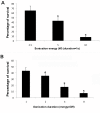Sonoporation-mediated gene transfer into adult rat dorsal root ganglion cells
- PMID: 20525259
- PMCID: PMC2890659
- DOI: 10.1186/1423-0127-17-44
Sonoporation-mediated gene transfer into adult rat dorsal root ganglion cells
Abstract
Background: Gene transfer into many cell types has been successfully used to develop alternative and adjunct approaches to conventional medical treatment. However, effective transfection of postmitotic neurons remains a challenge. The aim of this study was to develop a method for gene transfer into rat primary dorsal root ganglion neurons using sonoporation.
Methods: Dissociated cells from adult rat dorsal root ganglion (DRG) cells were sonicated for 1-8 s at 2.5-10 W to determine the optimal ultrasound duration and power for gene transfection and cell survival. Transfection efficiency was compared between sonoporation, liposome and lentiviral vector gene transfer techniques.
Results: The optimum ultrasound intensity was 5 W for 2 s and yielded an efficiency of gene transfection of 31% and a survival rate of 35%.
Conclusions: Sonoporation can be optimized to minimize cell death and yield a high percentage of transfected neurons and that this technique can be easily applied to primary cultures of rat dorsal root ganglion neurons.
Figures




Similar articles
-
Adeno-associated virus and lentivirus vectors mediate efficient and sustained transduction of cultured mouse and human dorsal root ganglia sensory neurons.Hum Gene Ther. 2001 Jan 1;12(1):77-86. doi: 10.1089/104303401450997. Hum Gene Ther. 2001. PMID: 11177545
-
Lentiviral gene transfer into the dorsal root ganglion of adult rats.Mol Pain. 2011 Aug 23;7:63. doi: 10.1186/1744-8069-7-63. Mol Pain. 2011. PMID: 21861915 Free PMC article.
-
Ultrasound-mediated gene transfer into neuronal cells.J Biotechnol. 2006 Apr 20;122(4):393-411. doi: 10.1016/j.jbiotec.2005.10.006. Epub 2005 Nov 22. J Biotechnol. 2006. PMID: 16309774
-
Particle-mediated gene transfer to rat neurons in primary culture.Pflugers Arch. 2000 Apr;439(6):730-8. doi: 10.1007/s004249900240. Pflugers Arch. 2000. PMID: 10784347
-
Lentiviral vector mediates exogenous gene expression in adult rat DRG following peripheral nerve remote delivery.J Mol Neurosci. 2012 May;47(1):173-9. doi: 10.1007/s12031-012-9710-z. Epub 2012 Feb 9. J Mol Neurosci. 2012. PMID: 22318316
Cited by
-
Optimization of ultrasound parameters for microbubble-nanoliposome complex-mediated delivery.Ultrasonography. 2015 Oct;34(4):297-303. doi: 10.14366/usg.15009. Epub 2015 Apr 22. Ultrasonography. 2015. PMID: 26044281 Free PMC article.
-
High-precision neural stimulation through optoacoustic emitters.Neurophotonics. 2022 Jul;9(3):032207. doi: 10.1117/1.NPh.9.3.032207. Epub 2022 Mar 23. Neurophotonics. 2022. PMID: 35355658 Free PMC article.
-
Non-genetic photoacoustic stimulation of single neurons by a tapered fiber optoacoustic emitter.Light Sci Appl. 2021 Jul 14;10(1):143. doi: 10.1038/s41377-021-00580-z. Light Sci Appl. 2021. PMID: 34257273 Free PMC article.
-
Evaluation of in vivo antitumor effects of ANT2 shRNA delivered using PEI and ultrasound with microbubbles.Gene Ther. 2015 Apr;22(4):325-32. doi: 10.1038/gt.2014.120. Epub 2015 Jan 15. Gene Ther. 2015. PMID: 25588739
-
Optimization of adult sensory neuron electroporation to study mechanisms of neurite growth.Front Mol Neurosci. 2012 Feb 8;5:11. doi: 10.3389/fnmol.2012.00011. eCollection 2012. Front Mol Neurosci. 2012. PMID: 22347167 Free PMC article.
References
-
- Cheon SH, Lee KH, Kwon JY, Choi SH, Song MN, Kim DI. Enhanced delivery of siRNA complexes by sonoporation in transgenic rice cell suspension cultures. J Microbiol Biotechnol. 2009;19:781–786. - PubMed
-
- Tsunoda S, Mazda O, Oda Y, Iida Y, Akabame S, Kishida T, Shin-Ya M, Asada H, Gojo S, Imanishi J, Matsubara H, Yoshikawa T. Sonoporation using microbubble BR14 promotes pDNA/siRNA transduction to murine heart. Biochem Biophys Res Commun. 2005;336:118–127. doi: 10.1016/j.bbrc.2005.08.052. - DOI - PubMed
Publication types
MeSH terms
Substances
LinkOut - more resources
Full Text Sources
Other Literature Sources

